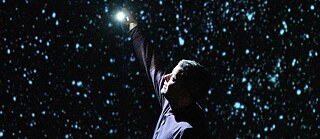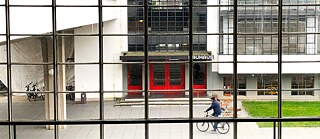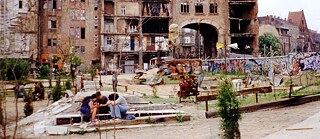Diving In
Immersion
Immersive artwork breaks down the border between the viewer and the artist, submerging the spectator in the exhibit. Nancy Pettinicchio discusses this dynamic at length with three artists.
Listen to this episode: Apple Music | Spotify | Download
This piece comes from Nancy Pettinicchio. Nancy is a filmmaker and podcaster from Montreal. Her work focuses on feminist and queer perspectives. She is currently working on the podcast series “Ce que le corps raconte,” which deals with the subjects’ relationships to their bodies in terms of gender, sexual orientation, and health. Find out more on her website. In this piece, Nancy interviews François Grisé, Zeesy Powers, and Thomas Oberender about their work. The music for this episode comes from Blue Dot Sessions.
Transcript
Nancy Pettinicchio: What’s the first thing that comes to mind when you hear the word ‘immersion’? I think about jumping into a body of water — a pool or a lake or the ocean — and the world sounds different. It’s both quiet and loud, you’re sinking and floating at the same time. The feeling of being underwater is complete and total immersion. This episode of THE BIG PONDER explores how we reach that feeling when we participate in artworks, when we, as audience members, join an artist’s constructed world. Welcome, my name is Nancy Pettinicchio, and I’m your host for this episode. I had the chance to speak with Dr. Thomas Oberender. Thomas’s background is in theater. He’s worked as a playwright, as a dramaturge, and as an author exploring the intersections between theater, other art practices, and society. He’s the Director of the Berliner Festspiele and the art director of the program named Immersion. He’s been asking questions surrounding this theme for years now.
Dr. Thomas Oberender: To say that there is no equivalent term in German language for immersion ... Five or six years ago, the term ‘immersion’ was only used by some media theorists and the university but not in the everyday language like it’s in the English language. If you say something is ‘immersive,’ it doesn’t mean it has to be related to art, it’s just a very intense feeling of being connected or diving in into something. But in German, we don’t have this kind of word. Maybe we say it’s ‘eindringlich’ or something, but nobody is connecting it with the art fields. This changed in the ’90s with the new media but only in this field of some very specialized artists and scientists in this field of new media.
Nancy Pettinicchio: Can you tell me, how do you determine if an artwork is immersive? How can you tell if it’ll fit within the Immersion program?
Dr. Thomas Oberender: I mean, the very old structure of exhibiting something is extracting something. You take it wherever it’s embedded and put it on a wall or put it in a vitrine. Then, the visitor is opposite of it, and you have the feeling you’re a subject, and this is the object, and you are free to choose your perspective, but you don’t think about the situation of this object, and you don’t think about your situation. You are a part of a structure that makes you feel like an individual that can choose its own way and tempo and everything. In the theater world, the experience is time-based; what’s going on on the stage is scripted by the play. And what we did is we started to script exhibitions, make time-based exhibitions, so basically nothing is fixed. It’s there, and you are here, and we started to develop infrastructure that welcomes you, that say, ah, you are there. The artwork is not the object on the wall. The artwork is the exhibition that includes you. This is very complicated technically, but it’s at the same time magic because you feel, wow, it’s an organism. It’s alive, and I’m a part of this life.
Nancy Pettinicchio: I also spoke to François Grisé, a multidisciplinary artist based in Montreal. François and I spoke face to face in the studio. I asked François to speak more specifically about his documentary theater project Tout inclus, or all-inclusive. In 2012, François parents moved to a seniors’ residence, adapting to their new home was difficult, though, so to better understand what his parents were going through, François decided to also move into a seniors’ residence despite being in his early 40s. He found Les Jardins du Patrimoines in Val-d’Or, about a seven-hour drive north of Montreal. François is not particularly interested in a distant academic type of research. Instead, to discover the complicated system that is Quebec’s retirement and care facilities for elderly people, François preferred to be physically present in one of those spaces because he needed to ask questions face to face. Tout inclus, or all-inclusive, is a documentary theater piece, where François plays himself. With fellow actors on stage, he alternates between reenacting his experience and speaking directly to the audience to narrate what it was like during his month-long stay at the residence.
François Grisé: The root of my practice is really wanting to amalgamate and stop being in only one specific practice, which was actor in the theater field. I wanted to have the possibility to use whatever was more so suited to the questions I was asking. What does the notion, what does the awareness of death, bring to the way we live our lives? So, that was my first diving into a topic in a very different way that was completely out of a theater practice. So, I created pieces — and I still do — that are set up and presented in a public space, so it was an intention of mine to get out of the traditional, ‘I’m buying a ticket to go to the theater, sit down in the audience, and listen to a story,’ which is fine, but I was more so interested in how I could bring these pieces into the world, into public spaces. And that’s the natural evolution of the things I’m doing now and that I will create in next years. They involve a participation, an active participation, of the people coming to not see the presentation, but be in and create the piece in a way. They’re not just a witness, they’re a participant and their influence make the piece evolve and advance and transform.
Nancy Pettinicchio: What drew you to performance as your initial medium, as your primary medium to begin with — and acting — and how do you think that’s maybe evolved over time?
François Grisé: Acting is presenting yourself in front of an audience and telling a story. I became very curious as to — what if that fourth wall that’s referred to in the theater world could be truly broken and that it would become a dance between, ‘oh, I’m not only an actor or an audience member, but I’m a bit of both.’ So, I’m not only an actor, I’m not only truly an audience member, there is a dance that can be created. And the other important part as a background is that I love theater, I hate theater, and when I hate theater, it’s because I’m sitting in the audience going, I don’t want to be here anymore. I’m stuck. I’m in the middle of a row, and I cannot leave. And I was deeply interested in how pieces could be much more inclusive, how that relationship could be two seconds or the full two hours. And that I’m satisfied with the public coming in for a short period of time and then taking a picture and leave or being involved completely and going from A to Z in the story that I’ve intended to present. Being stuck is not a feeling I like.
Nancy Pettinicchio: With reason.
François Grisé: I decided in that venture that I did of going to live with seniors for one month to be stuck. I was with them, but I was engaged. I wanted to be there. Sticking with it in that circumstance brought a lot of light and knowledge around a situation of which we are not very well informed because we don’t live it. What brought me to that place of investigating the notion of immersion was the notion of exclusion. From all of my personal stories, I know I’m very keen to listen to situations where I feel that people are excluded. Being aware of exclusion and the fear of being excluded propels me, and I’m very curious.
Nancy Pettinicchio: Can you describe your first impression of the residence? What was it like?
François Grisé: When I got to Les Jardins du Patrimoines, I was in shock, but I did not know it. The place that I was in was really clean — like too clean — and all of the lighting is fluorescent, so it’s too strong all the time. The room that I lived in was a half basement room, like a bachelor size. It was nice — very roomy, two windows, like full of light. It was a good place to be in, like I was in a good apartment. And the lady that was the director of the place had bought me ... All of the furniture that was there, belonged to a lady that had just died, so she bought all of the furniture from that family for me. And I guess, you know, now that I reflect on it, feeling out of place, being the youngster of 43 years old in a group of, you know, elderlies and being uprooted and feeling like you’re in a school, but it’s all old people, and you’re in a room that’s not yours in furniture that belonged to a dead lady that you don’t know. What’s truly frightening, and at a very cellular level, is that death is everywhere in those places. Everywhere. I remember after 20 days, I was in such a bad state of mind, I was like, yeah, death is in this glass, and death is in this Kleenex box ... And you know, but it’s true. It’s like, they know they’re going to die, and they’re fine with it, and they talk about it. They’re not fine with it, it’s not true, but it’s very present. You’re surrounded by people that more so in 20 years will be in the ground. So, I got to understand that that’s one of the roots of why it’s so frightening to be in front of aging people. That’s also one of the big, positive side of immersion is that there’s no distance anymore. You don’t say, ‘nos vieux,’ ‘les vieux’ — ‘the old people,’ ‘them.’ It’s like, no, no, no, they’re me. These people are me in 30 years, 35 years. So, it’s good. I think it’s good. It’s good, and I’ve learned something very rich.
Nancy Pettinicchio: I would love to know a little bit about how you prepared for your stay.
François Grisé: Well, I didn’t. Of course, I knew my questions, I had thought about it, but I think that at least there’s a thrill, and there’s an excitement in just diving in the pool. You know, the collaborator I’ve been working with, Annabel Soutar, often said, oh, it’s like you just jumped in the pool, and then, you went, holy shit, I’m in the pool! And truly, it is how I do it. I do it in the living of it. I prepare by living it, and that’s where the notion of immersion is very rich to me is that I just dive into the pool. And then I see, do I know how to swim this water or not? And if I need to learn something to swim this water, well, I will learn it with the people in the pool with me. I feel that when I have learned it that way, then it never goes. I know it. I know it in my bones. It’s not theory anymore.
Nancy Pettinicchio: It’s like muscle memory.
François Grisé: Absolutely. Documenting reality in a fictional world was very interesting to me again, and it’s fictional. And yet: we’re all in a room, it’s eight o’clock, the show starts. So, it’s right now. It’s also, again, that notion of right here, right now. We are in front of one another, and we will hear a story. That’s what Tout inclus is.
Nancy Pettinicchio: The last artist I had the chance to speak with is Zeesy Powers. Zeesy is also a multidisciplinary artist. We had a video call since she’s based in Toronto. She was in her home sitting at a desk in front of a laptop, and I asked her to describe the space she was in for us.
Zeesy Powers: It’s a little bit windy, and so, that means that the old trees outside are creating sort of a dappled sunlight and shade in this room.
Nancy Pettinicchio: In 2017, Zeesy exhibited a virtual reality piece named This Could Be You. The project started as a means of researching and better understanding virtual reality. Zeesy was curious about this seemingly goofy yet incredibly expensive technological experiment that most people won’t really have the chance to have a meaningful experience with. If you put yourself in the shoes of the participant, what do you experience when you encounter this piece?
Zeesy Powers: In This Could Be You, the experience is something that I really intended to be something very uncomfortable but still physically accessible. So, I wanted to build something that a person would be able to have a high degree of mobility and control within, that there would be no learning curve, and that the entrance into this body would be seamless. I came to this thing of like, what is a body that makes me feel really uncomfortable that isn’t about somebody else? And I really realized, it’s me as an elderly person. And the reasons for this are sort of twofold. We live in a very youth-focused culture, and to be elderly is something that’s very fearful, especially from a physical point of view. And on top of that, in terms of making an avatar that’s VR-friendly, it was pretty much impossible for me to make a 90-year-old body that was accurate without actually having to like go in and program something in the backend. So, it ends up being this very uncomfortable feeling of you’re looking at this like very haggard elderly face with a bald head, naked, with a body that’s actually quite youthful. And this person’s in this landscape that is completely devoid of any sort of organic matter. The ground is concrete. There’s no trees, there’s no plant life. There’s no animals, and they’re alone, completely alone. And they are surrounded by a lot of e-waste. This garbage is raining on top of you, and you’re facing yourself, so you see your body when you look down on it, but you also see your mirror directly across from you. And every time she’s hit by flying cell phones, way out of scale, some toilet paper, whatever it is, CDs, it impacts her body. And every time you are hit, it impacts your body, and you’re both the same body.
Nancy Pettinicchio: Do you think that immersion is something that only happens when we explore the unfamiliar? If it’s something that’s, whether it be through an unfamiliar technology, a technological experience, or an unfamiliar setting, or do you think we’re immersed also in the familiar in our everyday lives?
Zeesy Powers: Well, we talk about immersion as a technological experience or experience of difference or sameness. I mean, we’re really talking about, are we always immersed in where we are, or is that an experience that we have to have sort of mediated somehow? VR is interesting in this way where it’s like, oh, you’re given a tool to immerse yourself in another experience to generate empathy, to generate awareness. But I think that, again, that sort of narrative of VR creates empathy, which is also something you’d really see in this sort of mid-20-teens boom, where everybody’s like, we’ve got a headset that our lab can afford, so we’re going to create a program with a team of psychologists. If that tool works for people, I think that’s really powerful and those experiences of immersion in a place that’s not real, to come to a real place inside yourself is valuable. But I also do think, you know, through my research, looking at these things, I was consistently surprised by the lack of acknowledgement of the ways that those awarenesses can be reached just with other people. I wanted to create a space that, you know, I feel uncomfortable in, that is frightening to me, but that through that is also giving people a physical experience that they are not confronted with ever because it is fantastical, but the elements inside it are very clearly referencing a future we’re all afraid of. In sci-fi, in literature, especially, a term that I think really accurately describes some of the most beloved works of sci-fi is ‘world-making,’ where the artist is — or the writer — is able to just, through words alone, create a whole other world that we can find ourselves immersed in and completely believable. No matter how fantastic it is, we can understand this as a place that could really be.
Nancy Pettinicchio: When I spoke with Dr. Thomas Oberender, who you heard at the beginning of the episode, he told me that every art form is a type of ‘world-building.’ When I asked him about his thoughts on escapism and immersive artworks, he told me that when you escape, you escape to reality, not to something different. He said it’s just a different kind of reality, it’s not not real, wherever you go. Thomas pointed out that we can refuse the dialectic structure of ‘this is reality and art is something different,’ and say, no, art is simply another quality of being real. Did you have an intention of there being a specific outcome?
Zeesy Powers: When I made it, I was just interested in what I would experience for myself and making sure that people were able to experience it with as few external limitations as possible. You have to remember, VR and what we kind of are seeing as VR now, really just started in 2015. And when this piece came out in 2017, it was so novel to most people, and I think it still is. This was also a time when climate disaster was still something we could pretend was a one-off or a freak incident. And sitting here in 2021, seeing that what we knew, what was going to happen anyway, that the world is simultaneously underwater and on fire and will probably be like that for the rest of our lives. That feeling of like, ‘oh, it’s just trash, there’s nothing left but trash,’ was operating on a very subtle level with people. And I think for somebody to experience the piece today, whether or not they have experienced VR in the past, I’d be really curious, but overall people’s interactions with my VR work in this case were so much about that kind of novelty and ‘wow’ factor of the technology.
Nancy Pettinicchio: What is the link with aging and kind of the complicated and challenging future that that we’re facing?
Zeesy Powers: Aging is terrifying to us. We see it, we conceptualize it as this thing of a terrifying decline of our bodies and minds as opposed to this progression to a point where your life experience is valuable. To be someone approaching the end of their life in a world where our resources are completely depleted, we are facing constant crises that are literally destroying our homes and forcing mass migrations, it’s a frightening idea. If we can’t take advantage of the resources around us, we are going to just drown in them as a burden and a problem as opposed to something that we can use to help survive and move forward in the future. Art is always a reflection of its time. What you’ll see over and over again, is that the statements that art makes about what the future could be are also very deeply rooted in what the present is. I think people really need to be able to see the difference between being funneled into something that is essentially just treating them as a data point and engaging with something that allows themselves to be, you know, immersed in a world without letting the participant be exploited themselves. In the case of VR and new and emerging technologies, it’s really about, you know, fundamentalist capitalism. Have you become the commodity? And if you are the commodity and you don’t even realize it, that’s a problem.
Nancy Pettinicchio: Immersion is a means of tackling difficult questions, of facing things head-on. Immersing ourselves in artworks has always been essential in shaping the future because they allow us to question the present. Here’s Thomas with some final thoughts.
Dr. Thomas Oberender: Our last project was about climate change because climate system is a system in which you can’t stand out of it. So, one of our big exhibitions was named Welt ohne Außen, world without outside, and it means there is no outside anymore. You’re always embedded in something that you are influencing and you are influenced by. Immersion is not about shaking walls in a museum, it’s about the shaking of the world itself. Everything that is deep and intense is immersive, it’s denying the border between you and the world.
Nancy Pettinicchio: This was “Immersion,” an episode of THE BIG PONDER, hosted by me, Nancy Pettinicchio. Thank you to our three participants and to you for listening.







